2012/13 was the last season in which RB Salzburg wasn’t the team which won the Austrian Bundesliga as in this campaign Austria Vienna stood at the end on the top of the table. Since then Salzburg won the Austrian Bundesliga in every single season.
At the end of the last campaign, RB Salzburg had 52 points while Oliver Glasner’s team LASK Linz collected 40. Then, Glasner left Linz to take over the German Bundesliga team Wolfsburg and the big question was how good LASK would be after the new head coach Valérien Ismaël takes them over.
Now, 18 games are played and just four are left until the 12 teams of the Austrian Bundesliga get divided into two groups and in the groups, it will be decided who becomes champion and who gets relegated respectively. Linz currently has 42 points and sits in the second position just two points behind RB Salzburg while the third team (Rapid Vienna) is 10 points behind Linz. Even though the points get halved after the opening 22 games, it seems like LASK and Salzburg will be the two teams who fight for the title.
In this tactical analysis in the form of a scout report, we’ll investigate LASK Linz’s tactics and system to understand why they could be the first team in years to really challenge RB Salzburg.
The system and players
Ismaël continued to use the same system and formation which Glasner installed at Linz: a 3-4-3. This formation sometimes looks like a 3-4-2-1 formation and when they defend deeper it also seems to be a 5-4-1 system on other occasions. However, these are small variations and, logically, formations don’t always tell the whole truth. We’ll come back to these different positionings of the players which lead to the small variations, but in general, they primarily use a 3-4-3 formation which can be seen for example in the shot below (red team).
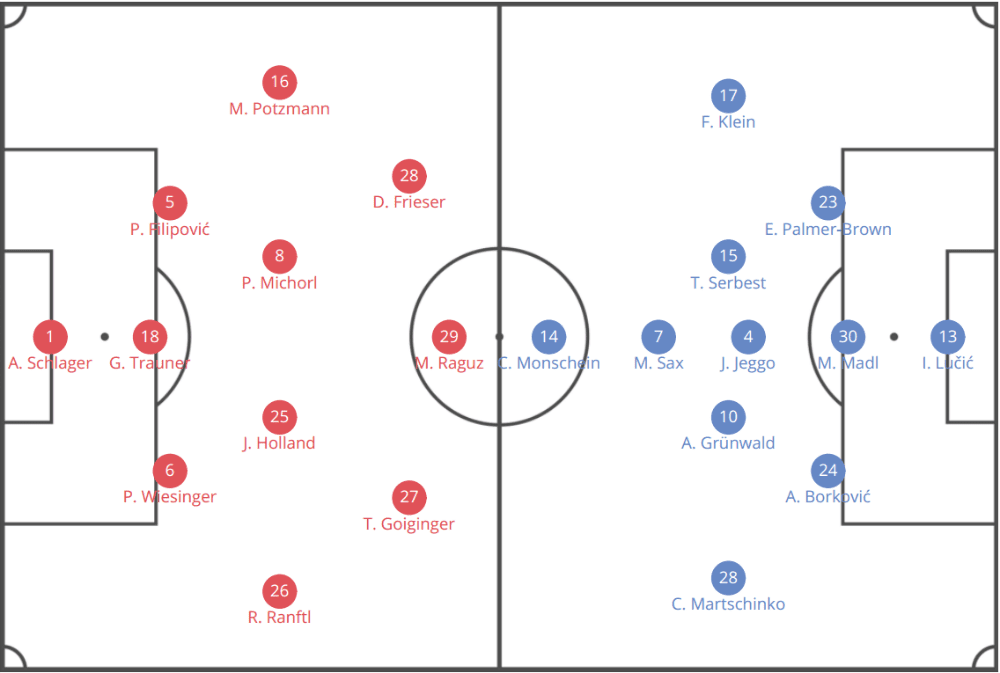
The back three was until now mainly made of the four players Gernot Trauner, Philipp Wiesinger, Petar Filipovic and Markus Wostry while the goalkeeper was in every game Alexander Schlager who will likely be the first-choice keeper of Austria’s head coach Franco Foda at the Euros 2020.
Peter Michorl and James Holland were in almost every game the two central midfielders while Reinhold Ranftl and Rene Renner were mainly the two wing-backs. The front three was mostly made of Thomas Goiginger and Dominik Frieser on the wings while Ismaël used in the centre-forward position either Klauss or Marko Raguz.
So, they mainly rotated in the back three and also switched the centre-forward while the other players mostly stayed the same. Due to that, the players got used to each other while the variation of the two strikers gave them at least a bit of variability in personal. We’ll now take a closer look at their tactics and how they work out in their 3-4-3 system.
In possession
In general, since LASK is one of the stronger teams in the Bundesliga besides the likes of RB Salzburg, Rapid Vienna and Wolfsberger AC, their opponents mostly sit back deeper against them and don’t press in at them. Due to that, it’s no surprise that they have on average 56.77% possession. This value tells that they are usually the more dominant team, but they aren’t as dominant as for example Salzburg who have on average 64.4% possession.
Besides, in the last season under Glasner, they had a lower value with 51.15% as the Austrian coach wanted them to play an extremely vertical style of football. The current head coach Ismaël also expects from his players that they should play penetrating vertical passes when the option occurs but wants his team to have a calmer and more organised build-up. One factor which is vital to have a good and structured build-up from the back is logical that the players in the deeper areas permanently have enough passing options to circulate the ball to then progress the ball further up the pitch when the right situation comes. For that, the creation of triangles is an often-used method and Linz also do so.
In general, the 3-4-3 formation includes several triangles while the three which are created by the back three and the two central midfielders are surely three of the most important ones. These five players are responsible to keep the ball until they find a way to progress the ball into the higher lines. At least one of the two central midfielders stays deeper while the other one either positions a bit higher or also stays deeper depending on the structure of the opponents. Often, we can see that Holland stays deeper to help the back three while Michorl moves a bit forward. In the example below, Michorl (#8) also stays near his defenders as there is a lot of space in the centre. In this shot, we also can perfectly see the three triangles and how the back three creates together with the central midfielders a kind of an “M” during the first stage of the build-up.
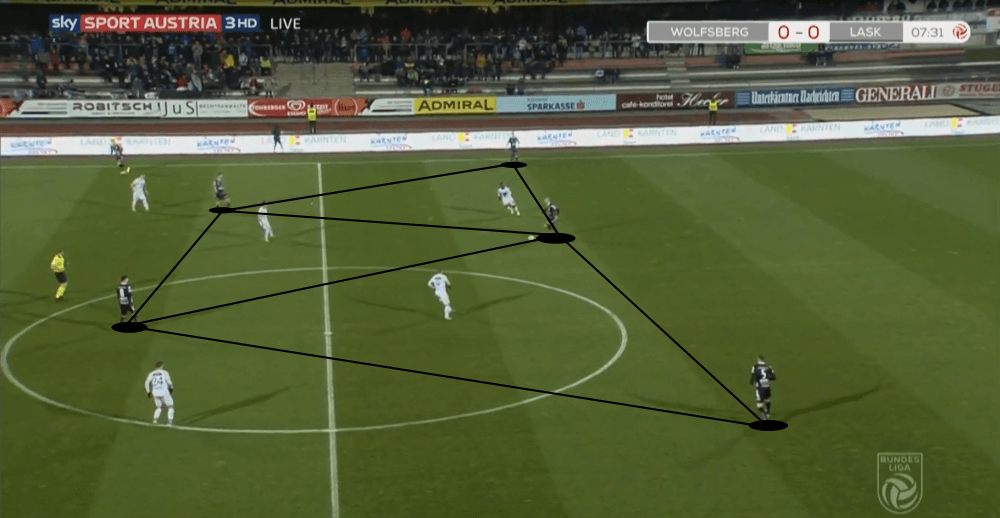
As we will see later on in this analysis, the wing-backs are extremely important for the tactics of LASK Linz since Ismaël’s team does not just build-up their attacks through the centre. They like to attack over the wing and also through the centre to be more variable. To do so and to be able to progress the ball up the pitch with the aid of passing combinations, the player on the ball always needs short passing options. As we already saw, in the deeper areas this is possible because of the triangles which are created by the five central players.
However, the positions of the remaining five players are also in a way that it is possible for them to permanently create triangles. The wing-backs usually position very wide to provide width and stretch the opposition while the two wingers which are part of the front three are positioned more narrow to avoid that they are on the same vertical line as the wing-backs. This can be seen in the example below as the right-winger Samuel Tetteh is positioned more centrally to create a triangle with the central midfielder Holland and the right wing-back Ranftl. This positioning can usually be seen by both wingers, but the opposing one is currently out of the image.
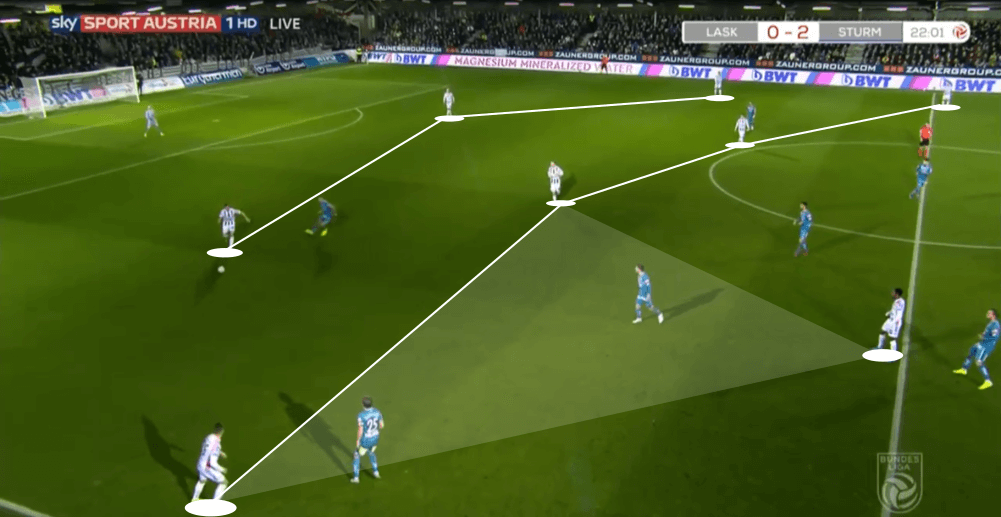
These several triangles help the players of Linz to have several short passing options and play passing combinations. The other advantage of the central positioning of the wingers is that they force the opposition to stay more horizontal compact what creates space for the wing-backs, but we’ll look at this mechanism more detailed later in this tactical analysis.
Anyways, Linz doesn’t just use short passes to get into the higher lines to create from there goalscoring chances since they also often make use of long balls. No other team in the Austrian Bundesliga play as many long balls as they do (56.55 per 90 minutes). However, this has several reasons as firstly the two wingers are mainly positioned central and due to that all three forwards are in the middle and can support each other when they receive the passes. Secondly, Klauss and Raguz are both physically strong and due to that, they are centre-forwards who can receive such long balls and stay in possession.
Since these long balls aren’t always high in the air, but also often low ones to give the physically weaker wingers the chance to collect them, the three forwards often position between the lines of the opposition to create distance between themselves and the defenders. Due to that, we can often see how one of the three centre-backs plays a penetrating pass to find one of the three forwards between the lines. Such a situation can be seen in the example below. Even though the midfielder of the opposition can block this pass, we can still perfectly see how the two wingers and the striker are positioned in the space in front of the opposing defence to provide deep passing options.
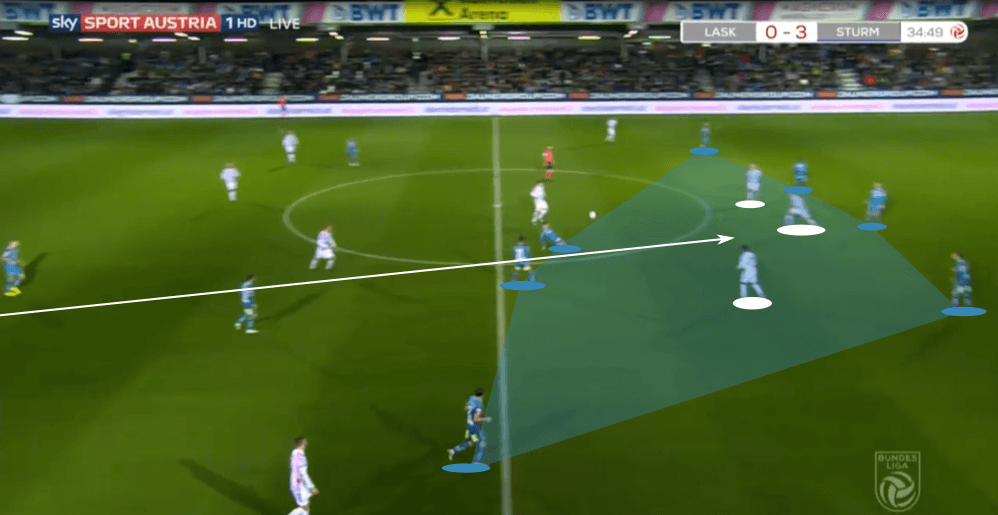
When Linz is able to get into higher lines, the three forwards continue to stay central. Firstly, this has the advantage that the wing-backs have more space and options in the wide-areas as we’ll see in the next paragraph of this scout report. Secondly, Ismaël’s team always have enough men in the centre for a cross. As already mentioned, Klauss and Raguz are physically strong and due to that able to convert crosses into goals and additionally they receive support from the two wingers. This gives the player on the ball in the wide-area easily enough options for a cross. This also can be seen in the example below as the centre-back Trauner finds himself in a higher position on the right-wing after he has received a through pass from the right wing-back Ranftl. Trauner delivers a cross that makes sense as all three forwards can be found in the penalty box.
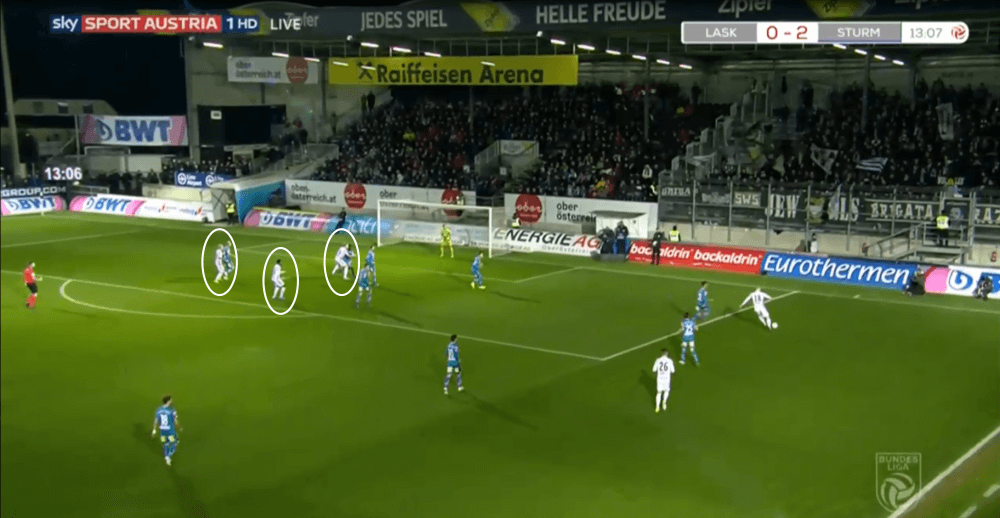
The fact that the central man of the back three Trauner finds himself in such a high area of the field in the shot below might look really surprising at the first glance, however, Ismaël wants to see exactly that from his defenders. So, we don’t see permanently vertical runs by the defenders of the back three, but when they have the option in a good situation, they are encouraged to do so as we can see in the two examples below. The first one shows Trauner making a vertical run after he won back the ball in a higher position. This run results in the situation which can be seen in the shot above. The second image shows Wostry dribble forward as he has quite some free space ahead of him.
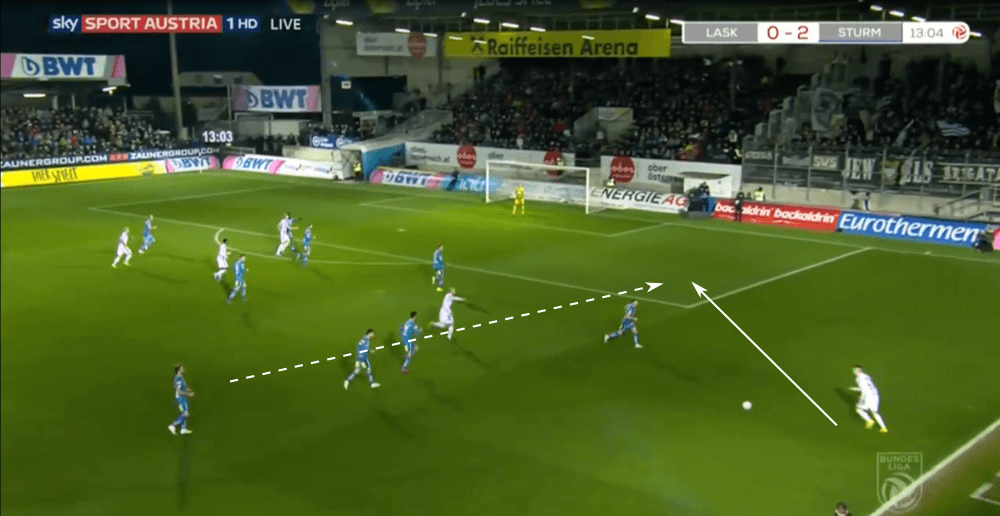
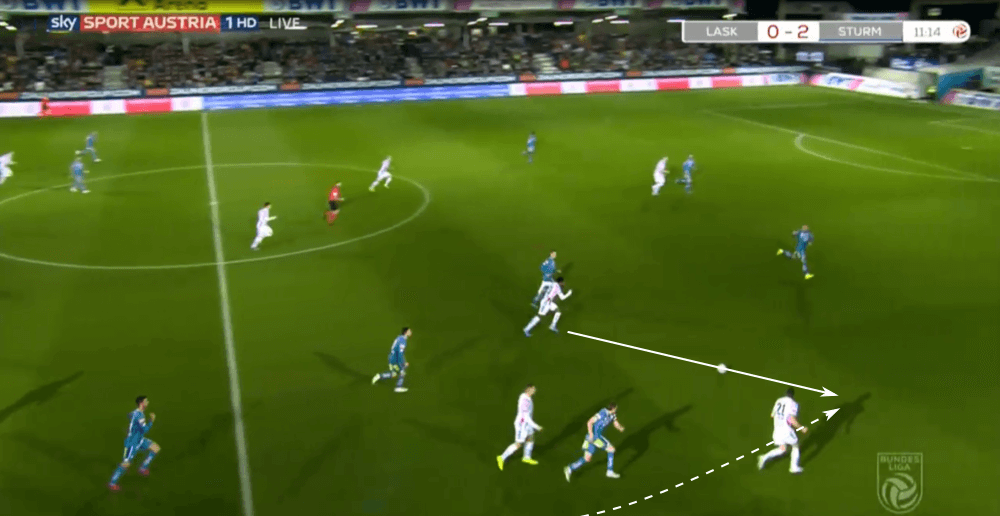
The importance of the wing-backs
I briefly mentioned how important the wing-backs are for the tactics of Linz. Firstly, they provide width since they are the only players in the whole team who really should permanently stay in the wide areas. Besides, they have the task of creating triangles with the central players to progress the ball further up the field. Their role during the defensive moments will be described when we look at LASK’s defensive tactics later in this analysis.
Anyways, Ismaël wants the wingers to create space for the wing-backs. This can happen in two ways which both are shown in the images below. The first mechanism is as simple and effective as the winger takes his position in the half-space to then make a diagonal or horizontal movement into the centre. Ahead of this run, the wing-back is positioned deeper, giving him some yards to pick up speed before he receives the ball. So, the movement of the winger creates space for the deeper positioned wing-back as he pins the opponent. The wing-back can sprint into the created room to receive the ball when he is already running as it can be seen in the shot below.
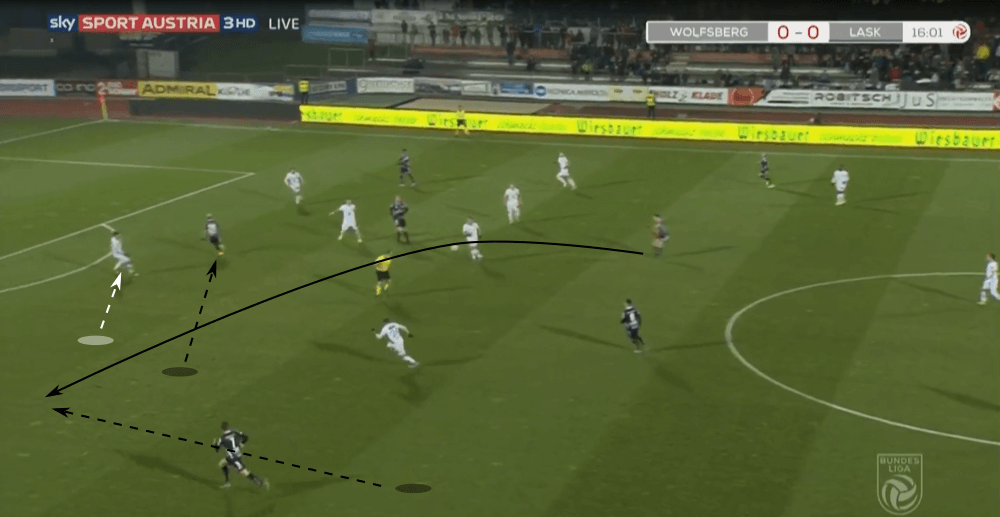
The second pattern was already explained, because as soon as the ball is played into the higher areas of the pitch, the three forwards mostly position themselves in the penalty area to receive balls into the box. This also has the advantage that they force the opposition’s defence to stay more compact and have more men in the central area in front of the goal. This doesn’t just create space for the wing-backs, but also frequently gives him the chance to go into a one-on-one situation with an opponent as is visible in the example below.
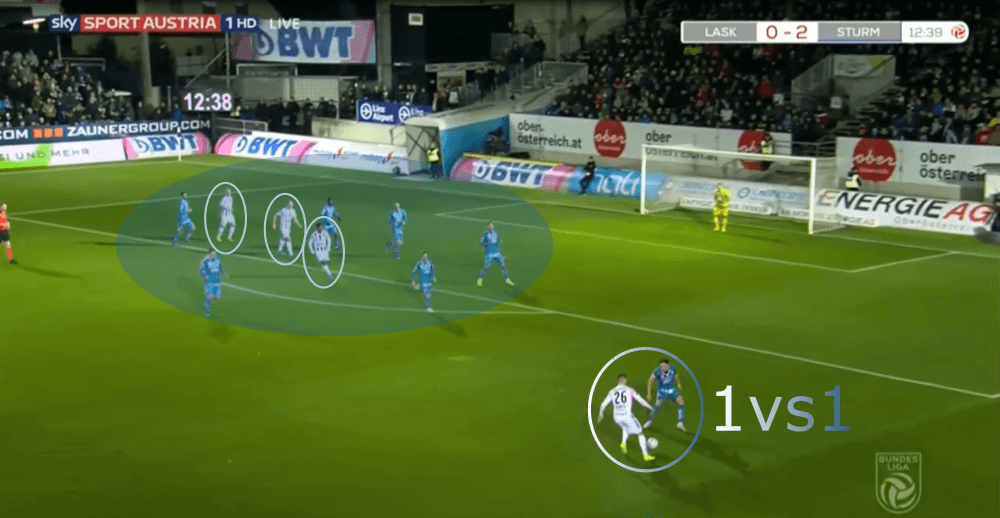
So, we already saw that the three forwards, and in particular the two wingers, help the wing-backs massively with their movements and positionings. Anyways, in some situations, it’s also vice versa and they help each other respectively. Since Linz plays with a back three and the two central midfielders mainly stay a bit deeper, they can instantly start the counter-pressing, the wing-backs have the freedom to support the three forwards in the highest line.
Due to that, we can quite often watch how the wingers and wing-backs work together to overload one side and create space for each other and provide the deeper players two passing options at the same time. This makes it often extremely hard for the opposition’s players to defend in such situations as it can be seen in the example below.
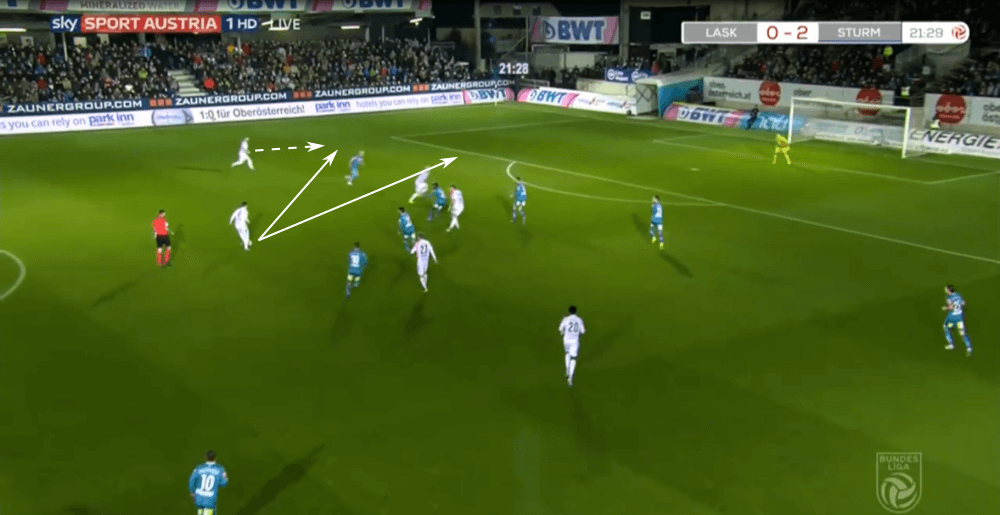
Aggressivity to win back the ball
During his time at Linz, Glasner installed an aggressive high press which made them one of the best teams in the highest division of Austria. In light of this, it’s no real surprise that Ismaël and his team continue to use these tactics. Besides, the fact that they use high pressing and counter-pressing in every game also explains why they have on average 56.77% possession per game in the Austrian Bundesliga.
Furthermore, a value which is nowadays often used to identify how aggressive and good a team press is the PPDA (passes per defensive action). It’s no surprise that RB Salzburg has the best value in this category in Austria with 5.5. The team with the second-best value in the Austrian Bundesliga is LASK with 6.55 followed by Wolfsberg with 6.59. Anyways, the next-best team is St. Pölten with 8.06. Considering this, we clearly see that Salzburg, Linz and Wolfsberg are the three teams in the league with the most aggressive and effective pressing.
As you can see in the example below, Linz uses a man-orientated and high pressing. Every single offensive player looks for one or two opponents which they either man-mark or try to cut off the passing option with the aid of their cover shadow.
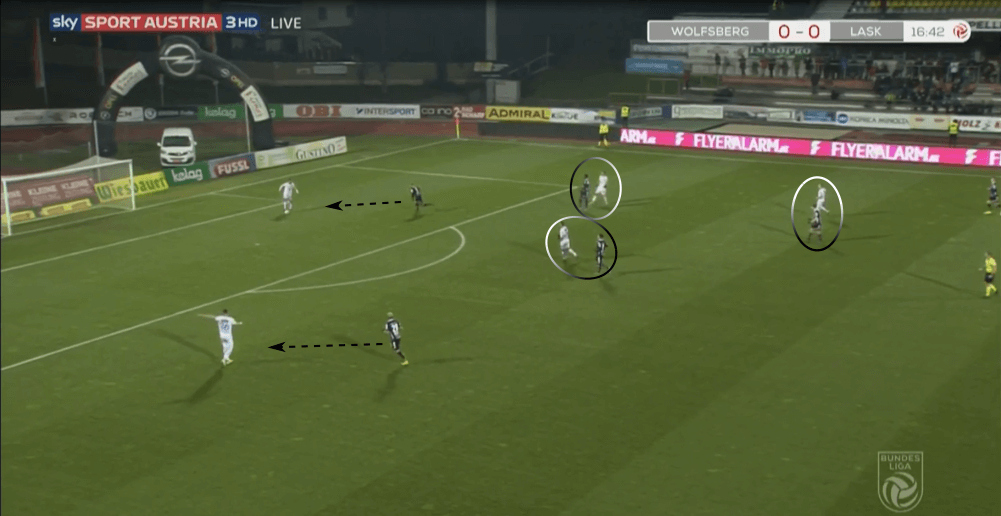
They also want to win the ball back as soon as possible when they lose it and execute an aggressive counter-pressing. Their opponents have on average 2.63 passes per period of possession which is a clear indicator that shows their pressing and counter-pressing often work well. As we already saw an example of the man-orientated high pressing above, in the shot below we can see a situation one second after they lost the ball in front of the opposition’s penalty box. Linz’s players immediately start the counter-pressing as they want to get back in possession of the ball as fast as possible.
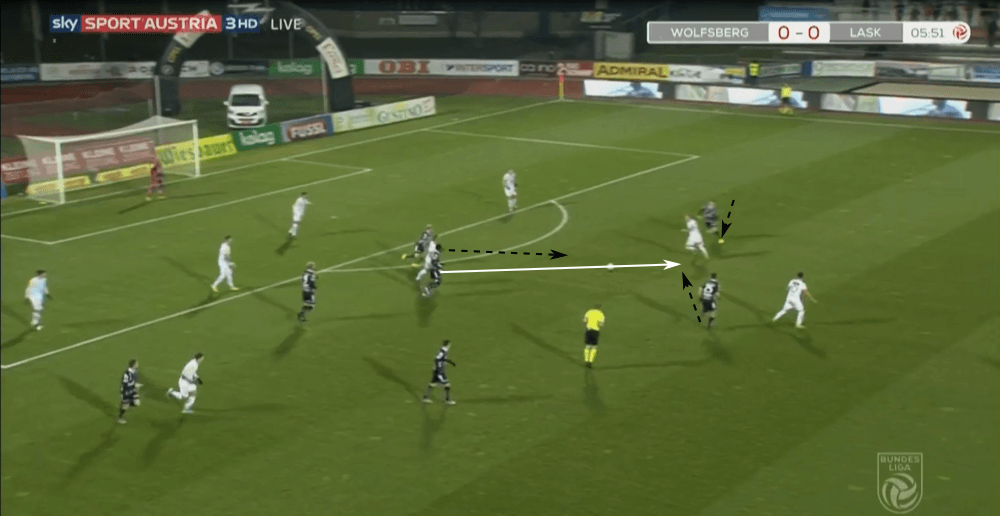
The important thing during a high press or a counter-press is that the defenders also push forward to keep the vertical compactness alive. In this case, the back three of LASK should position high and move forward together with the remaining players of the squad who execute the press. Mostly the three defenders do so as it can be seen in the image below and it also gets visible how it pays off. If they were positioned deeper, the opponents would have space which they could use to progress the ball. However, due to the high positioning of the back three, Wiesinger can get into the duel with an opponent and win it (circled).
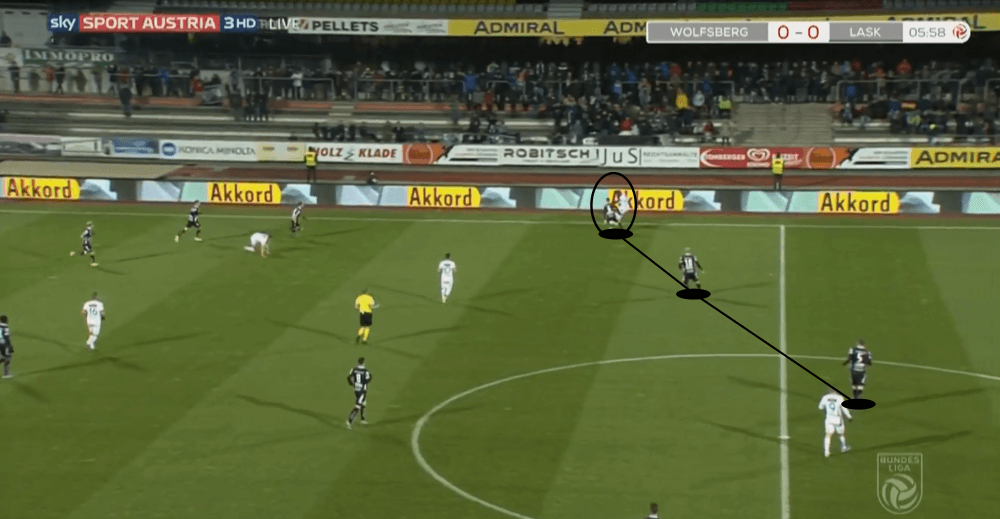
As already mentioned in this tactical analysis, Linz likes to operate with long balls and try to find the forwards with them. Anyways, these long balls also have another task which isn’t clearly seen at first glance. Linz uses long passes to instantly start the counter-pressing if they aren’t able to stay in possession of the ball in the higher lines. To do so, the whole team has to push forward as soon as the ball is played and due to that, it’s not that bad if the opposition intercepts the ball since this gives them the chance to use the counter-press and win back possession in a high area of the pitch.
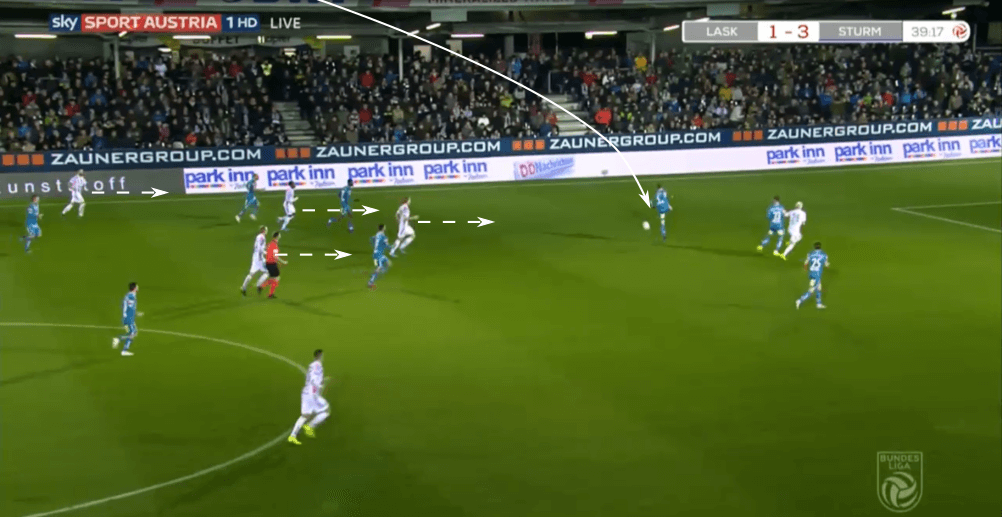
Defending deeper
Logically, a team can’t execute a high and aggressive (counter-)press for 90 minutes. Due to that, Linz also has periods in the game where they sit back deeper, defend in a mid-block and let the opposition structure their build-up in their own half without putting pressure on them.
In these situations, the wing-backs drop deeper to create a back five and the team switch to a 5-4-1 and 5-2-3 respectively depending on the positioning of the wingers. In the shot below, it looks like a 5-2-3 formation for example.
The interesting thing is now that they stay in general horizontal and vertical compact. Notice in the shot below how short the distance is between the deepest defender, Trauner, and the central striker, Klauss, is. Besides, they extremely shift towards the side where the ball is played to always have numerical superiority in the space around the ball.
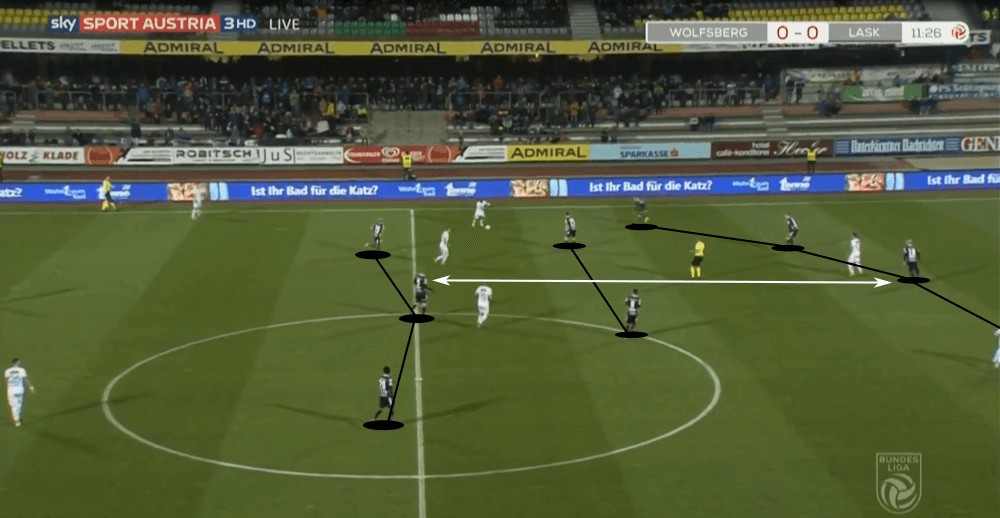
To shift towards the side where the ball is played to stay compact is something completely normal and logical in modern football. However, in this season one problem occurred several times when Linz defended deeper as it sometimes seemed as the wing-backs (and the whole defence) focused so much on the ball when it got played in one wide-area and shifted towards it, that they forgot the space behind them.
This can be seen in the situation below which also resulted in a goal. As the ball is played onto the right defensive side of Linz, the players are all focused on the ball and shift towards it. They completely forget about Tomas Ostrak who then received the ball and scored the 1:0.
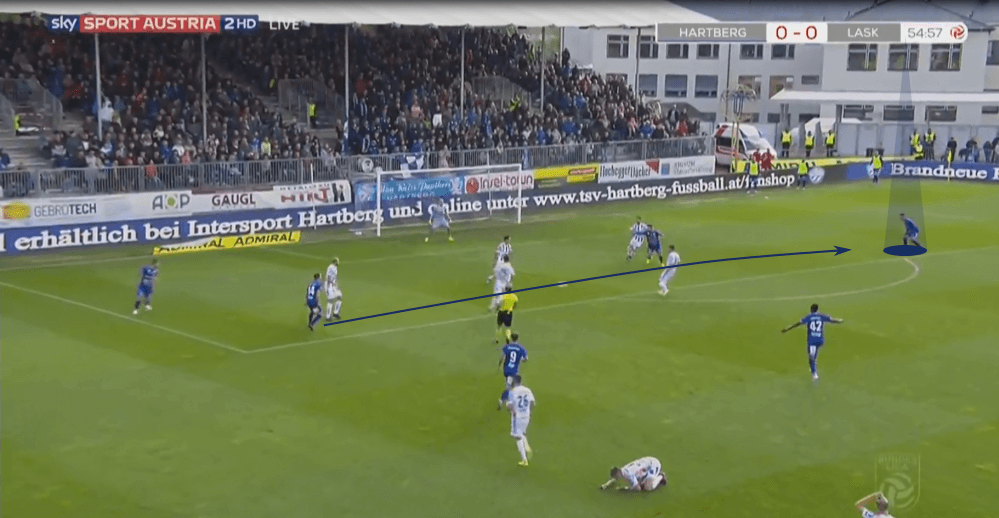
Conclusion
LASK Linz has put on some outstanding performances and showed that, after the departure of Glasner, they are the only team in Austria who are really able to challenge RB Salzburg. It’s a joy to watch their offensive style of play combined with the (counter-)pressing. They need to work on their tactics during the periods when they sit back deeper since this is one of the parts of the game where they can improve the most.
When the winter break is over, they’ll face RB Salzburg away from home on 14 February. This game will be quite deciding and will show us how good Linz really is this season. Since after the opening 22 games the points will get halved, the race for the title could be really interesting this season in Austria.

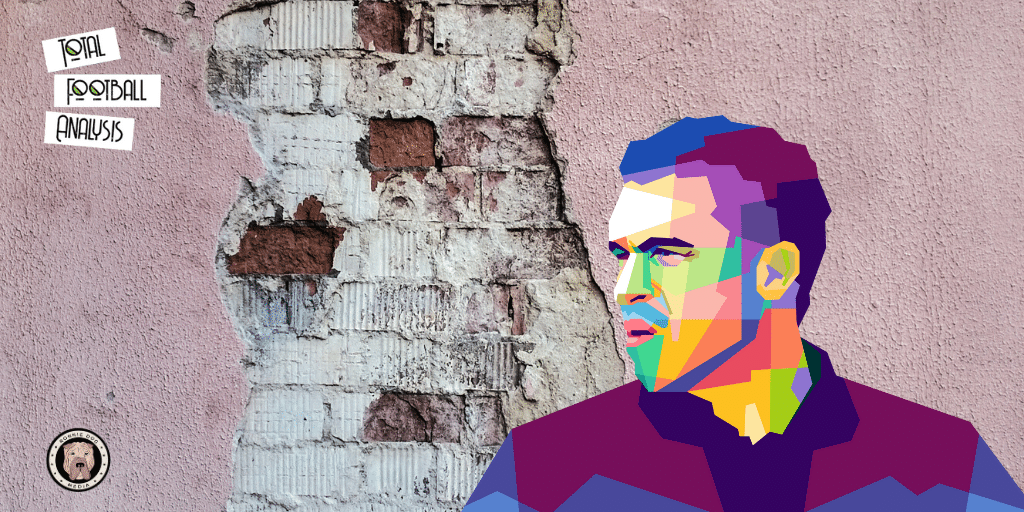



Comments